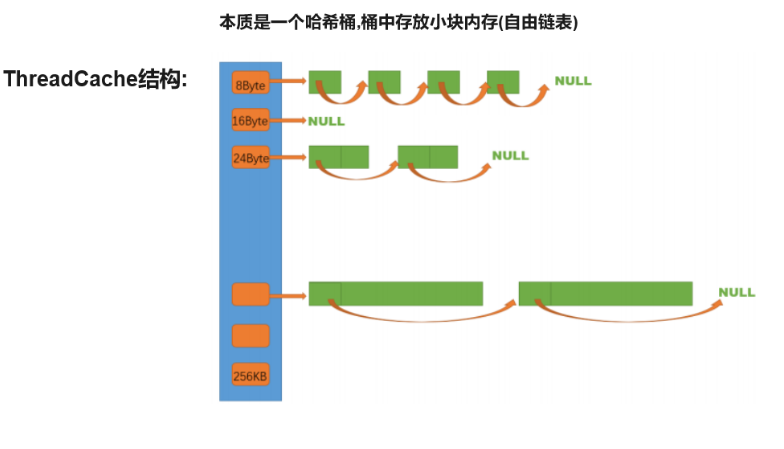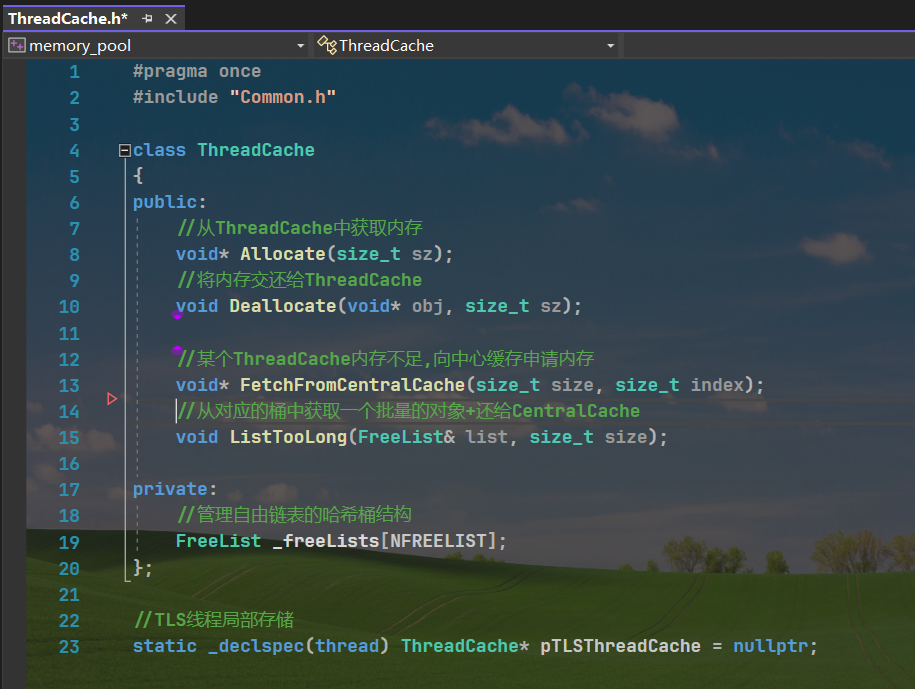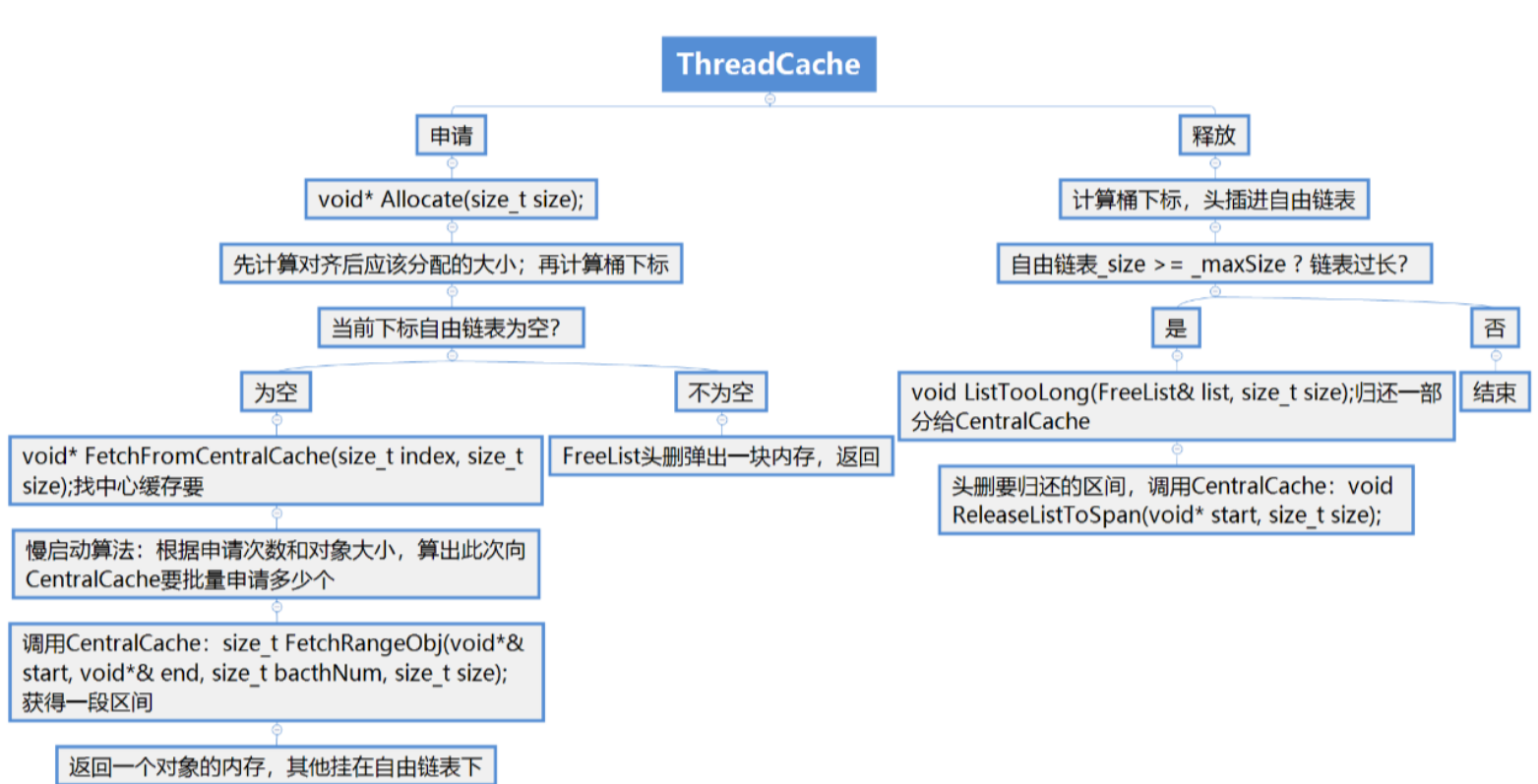一.ThreadCache整体结构
1.基本结构
定长内存池利用一个自由链表管理释放回来的固定大小的内存obj。
ThreadCache需要支持申请和释放不同大小的内存块,因此需要多个自由链表来管理释放回来的内存块.即ThreadCache实际上一个哈希桶结构,每个桶中存放的都是一个自由链表。

2.对齐规则和下标索引
规定ThreadCache 支持**<=256KB内存** 的申请,如果我们将每种字节数的内存块都用一个自由链表进行管理的话,那么此时我们就需要20多万个自由链表,光是存储这些自由链表的头指针就需要消耗大量内存,这显然是得不偿失的。
这时可以选择做一些平衡的牺牲,让一定区间内 的字节数 统一为某个size,
然后用一个桶的自由链表 来管理.
即按照某种规则进行内存对齐(但同时产生内碎片问题)

二.函数调用层次结构


//小于等于MAX_BYTES,就找thread cache申请
//大于MAX_BYTES,就直接找page cache或者系统堆申请
static const size_t MAX_BYTES = 256 * 1024;
//thread cache和central cache自由链表哈希桶的表大小
static const size_t NFREELISTS = 208;
三.FreeList的封装
NextObj管理内存obj的前4/8个字节,用来指向下一块内存
size_t _maxSize = 1;//此时一次申请的最大obj个数
size_t _size = 0;//自由链表中的内存obj的个数
cpp
static void*& NextObj(void* obj)
{
return *(void**)obj;
}
// 管理切分好的小对象的自由链表
class FreeList
{
public:
void Push(void* obj)
{
assert(obj);
// 头插
NextObj(obj) = _freeList;
_freeList = obj;
++_size;
}
void PushRange(void* start, void* end, size_t n)
{
NextObj(end) = _freeList;
_freeList = start;
_size += n;
}
void PopRange(void*& start, void*& end, size_t n)
{
assert(n <= _size);
start = _freeList;
end = start;
for (size_t i = 0; i < n - 1; ++i)
{
end = NextObj(end);
}
_freeList = NextObj(end);
NextObj(end) = nullptr;
_size -= n;
}
void* Pop()
{
assert(_freeList);
// 头删
void* obj = _freeList;
_freeList = NextObj(obj);
--_size;
return obj;
}
bool Empty()
{
return _freeList == nullptr;
}
size_t& MaxSize()
{
return _maxSize;
}
size_t Size()
{
return _size;
}
private:
void* _freeList = nullptr;
size_t _maxSize = 1;//此时一次申请的最大obj个数
size_t _size = 0;//自由链表中的内存obj的个数
};四.字节数向上对齐规则RoundUp
1.RoundUp基本逻辑
cpp
static inline size_t RoundUp(size_t size)
{
if (size <= 128)
return _RoundUp(size, 8);
else if (size <= 1024)
return _RoundUp(size, 16);
else if (size <= 8 * 1024)
return _RoundUp(size, 128);
else if (size <= 64 * 1024)
return _RoundUp(size, 1024);
else if (size <= 256 * 1024)
return _RoundUp(size, 8 * 1024);
else
return _RoundUp(size, 1 << PAGE_SHIFT);
}2.子函数_RoundUp
cpp
size_t _RoundUp(size_t size, size_t alignNum)
{
size_t alignSize;
if (size % alignNum != 0)
{
alignSize = (size / alignNum + 1)*alignNum;
}
else
{
alignSize = size;
}
return alignSize;
}3.优化为位运算
cpp
static inline size_t _RoundUp(size_t bytes, size_t alignNum)
{
return ((bytes + alignNum - 1) & ~(alignNum - 1));
}五.字节数映射哈希桶下标Index
1.Index基本逻辑
cpp
// 计算映射的哪一个自由链表桶
static inline size_t Index(size_t bytes)
{
assert(bytes <= MAX_BYTES);
// 每个区间有多少个链
static int group_array[4] = { 16, 56, 56, 56 };
if (bytes <= 128) {
return _Index(bytes, 3);
}
else if (bytes <= 1024) {
return _Index(bytes - 128, 4) + group_array[0];
}
else if (bytes <= 8 * 1024) {
return _Index(bytes - 1024, 7) + group_array[1] + group_array[0];
}
else if (bytes <= 64 * 1024) {
return _Index(bytes - 8 * 1024, 10) + group_array[2] + group_array[1] + group_array[0];
}
else if (bytes <= 256 * 1024) {
return _Index(bytes - 64 * 1024, 13) + group_array[3] + group_array[2] + group_array[1] + group_array[0];
}
else {
assert(false);
}
return -1;
}2.子函数_Index
cpp
size_t _Index(size_t bytes, size_t alignNum)
{
if (bytes % alignNum == 0)
{
return bytes / alignNum - 1;
}
else
{
return bytes / alignNum;
}
}3.优化为位运算
cpp
static inline size_t _Index(size_t bytes, size_t align_shift)
{
return ((bytes + (1 << align_shift) - 1) >> align_shift) - 1;
}六.Allocate申请内存实现
在ThreadCache 申请对象时,通过所给字节数计算出对应的哈希桶下标 ,如果桶中自由链表不为空 ,则从该自由链表中pop一个对象 进行返回即可;但如果此时自由链表为空 ,那么我们就需要从CentralCache 进行获取了,即FetchFromCentralCache函数
cpp
void* ThreadCache::Allocate(size_t size)
{
assert(size <= MAX_BYTES);
//1.计算对齐后所需内存
size_t alignSize = SizeClass::RoundUp(size);
//2.计算要挂接的桶的下标
size_t index = SizeClass::Index(size);
if (!_freeLists[index].Empty())
{
return _freeLists[index].Pop();
}
else
{
return FetchFromCentralCache(index, alignSize);
}
}七.FetchFromCentralCache
每次ThreadCache 向CentralCache 申请对象时,我们先通过慢开始反馈调节算法计算出本次应该申请的对象的个数
如果ThreadCache 最终申请到对象的个数就是一个,那么直接将该对象返回即可。
当ThreadCache 中没有对象时,会向CentralCache中获取一个批量的内存obj(避免频繁申请)
ThreadCache 最终申请到的是多个对象,将第一个对象返回后,还需要将剩下的对象挂到ThreadCache对应的哈希桶当中。
cpp
void* ThreadCache::FetchFromCentralCache(size_t index, size_t size)
{
// 慢开始反馈调节算法
// 1、最开始不会一次向CentralCache一次批量要太多,因为要太多了可能用不完
// 2、如果你不要这个size大小内存需求,那么batchNum就会不断增长,直到上限
// 3、size越大,一次向CentralCache要的batchNum就越小
// 4、size越小,一次向CentralCache要的batchNum就越大
size_t batchNum = min(_freeLists[index].MaxSize(), SizeClass::NumMoveSize(size));
if (_freeLists[index].MaxSize() == batchNum)
{
_freeLists[index].MaxSize() += 1;
}
void* start = nullptr, * end = nullptr;
size_t actualNum = CentralCache::GetInstance()->FetchRangeObj(start, end, batchNum, size);
assert(actualNum >= 1);
if (actualNum == 1)
{
assert(start == end);
return start;
}
_freeLists[index].PushRange(NextObj(start), end, actualNum - 1);
return start;
}NumMoveSize的实现
cpp
// 一次thread cache从中心缓存获取多少个
static size_t NumMoveSize(size_t size)
{
assert(size > 0);
// [2, 512],一次批量移动多少个对象的(慢启动)上限值
// 小对象一次批量上限高
// 小对象一次批量上限低
int num = MAX_BYTES / size;
if (num < 2)
num = 2;
//[0.5kb,128kb]
if (num > 512)
num = 512;
return num;
}八.Deallocate释放内存实现
当某个线程申请的对象不用了,可以将其释放给ThreadCache ,然后ThreadCache将该对象插入到对应哈希桶的自由链表当中即可。
但是随着线程不断的释放,对应自由链表的长度也会越来越长,这些内存堆积在一个thread cache中就是一种浪费,我们应该将这些内存还给CentralCache ,
这样一来,这些内存对其他线程 来说也是可申请的,因此当ThreadCache 某个桶当中的自由链表太长时我们可以进行一些处理。
当ThreadCache 某个桶当中自由链表的长度超过它一次批量 向CentralCache 申请的对象个数,那么此时我们就要把该自由链表当中的这些对象还给CentralCache
cpp
void ThreadCache::Deallocate(void* obj, size_t size)
{
assert(obj);
assert(size <= MAX_BYTES);
//1.将释放的内存还到_freeLists对应的桶中
size_t index = SizeClass::Index(size);
_freeLists[index].Push(obj);
//2._freeLists[index]挂的桶数大于最近的一个批量就还给CentralCache
if (_freeLists[index].Size() >= _freeLists[index].MaxSize())
{
//3.从桶中获取一个批量的对象+还给CentralCache
ListTooLong(_freeLists[index], size);
}
}ListTooLong获取内存块批量
cpp
void ThreadCache::ListTooLong(FreeList& list, size_t size)
{
assert(size > 0);
void* start, * end = nullptr;
//[begin,end]即为取出的批量
//将批量还给CentralCache对应的span
list.PopRange(start, end, list.MaxSize());
CentralCache::GetInstance()->ReleaseListToSpans(start, size);
}九.ThreadCacheTLS线程局部存储
每个线程都有一个自己独享的thread cache,那应该如何创建这个thread cache呢?我们不能将这个thread cache创建为全局的,因为全局变量是所有线程共享的,这样就不可避免的需要锁来控制,增加了控制成本和代码复杂度。
要实现每个线程无锁的访问属于自己的thread cache,我们需要用到线程局部存储TLS(Thread Local Storage),使用该存储方法的变量在它所在的线程是全局可访问的,但是不能被其他线程访问到,这样就保持了数据的线程独立性。
cpp
//TLS - Thread Local Storage
static _declspec(thread) ThreadCache* pTLSThreadCache = nullptr;十.ThreadCache.cpp
cpp
#include "ThreadCache.h"
#include "CentralCache.h"
void* ThreadCache::FetchFromCentralCache(size_t index, size_t size)
{
// 慢开始反馈调节算法
// 1、最开始不会一次向CentralCache一次批量要太多,因为要太多了可能用不完
// 2、如果你不要这个size大小内存需求,那么batchNum就会不断增长,直到上限
// 3、size越大,一次向CentralCache要的batchNum就越小
// 4、size越小,一次向CentralCache要的batchNum就越大
size_t batchNum = min(_freeLists[index].MaxSize(), SizeClass::NumMoveSize(size));
if (_freeLists[index].MaxSize() == batchNum)
{
_freeLists[index].MaxSize() += 1;
}
void* start = nullptr, * end = nullptr;
size_t actualNum = CentralCache::GetInstance()->FetchRangeObj(start, end, batchNum, size);
assert(actualNum >= 1);
if (actualNum == 1)
{
assert(start == end);
return start;
}
_freeLists[index].PushRange(NextObj(start), end, actualNum - 1);
return start;
}
void* ThreadCache::Allocate(size_t size)
{
assert(size <= MAX_BYTES);
//1.计算对齐后所需内存
size_t alignSize = SizeClass::RoundUp(size);
//2.计算要挂接的桶的下标
size_t index = SizeClass::Index(size);
if (!_freeLists[index].Empty())
{
return _freeLists[index].Pop();
}
else
{
return FetchFromCentralCache(index, alignSize);
}
}
void ThreadCache::Deallocate(void* obj, size_t size)
{
assert(obj);
assert(size <= MAX_BYTES);
//1.将释放的内存还到_freeLists对应的桶中
size_t index = SizeClass::Index(size);
_freeLists[index].Push(obj);
//2._freeLists[index]挂的桶数大于最近的一个批量就还给CentralCache
if (_freeLists[index].Size() >= _freeLists[index].MaxSize())
{
//3.从桶中获取一个批量的对象+还给CentralCache
ListTooLong(_freeLists[index], size);
}
}
void ThreadCache::ListTooLong(FreeList& list, size_t size)
{
assert(size > 0);
void* start, * end = nullptr;
//[begin,end]即为取出的批量
//将批量还给CentralCache对应的span
list.PopRange(start, end, list.MaxSize());
CentralCache::GetInstance()->ReleaseListToSpans(start, size);
}